How to Plant and Grow Snowdrops

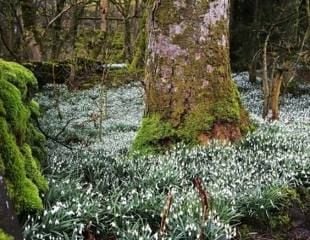

Key Points:
Height: varies from 8-10 cm (G. 'Tiny Tim') to giant snowdrops 30cm ( G.elwesii)
Light: As a woodland plant, best in partial/dappled shade
Soil: Moist, well-drained, preferably with added leaf mould and not in baked sun.
Special Features: Easy to grow, once established will multiply and create lovely winter colour. Different varieties of Snowdrop flower from Autumn to March.

Snowdrops are a green wheelbarrow plant because, although they can be tricky to get established, they are trouble-free and will multiply.
Where to plant Snowdrops and best growing conditions
Snowdrops are a mainly winter-flowering, fully hardy perennial bulbs. Planted in the right place, snowdrops will return and flower in your garden year after year.
Snowdrops are a woodland plant, which means their ideal growing conditions are partial shade, moist but well-drained soil. This is important because if the soil is too dry and the bulbs dry out, there is a real risk they will fail the following year. To grow snowdrops in drier areas, water them during dry spells until established. As a woodland plant, snowdrops are tolerant of partial shade, suitable for planting under deciduous trees and shrubs.
Plant Snowdrop bulbs about 10 cm deep, which is a little over 3 x the bulb depth, a handy rule of thumb for all bulbs. Because Snowdrops prefer soil that does not dry out, a mulch of leaf mould is ideal. Planting the bulbs a little deeper can also help to prevent the bulbs from drying out. Snowdrop bulbs hate to be baked in the hot summer sun; select a planting spot that is cool and semi-shaded in the summer.
Like Hellebores, snowdrop flowers hang down, and sometimes it's hard to see the lovely flower markings inside. Therefore, a wall or bank is ideal for planting them to clearly display the flowers. Professional growers sometimes display snowdrops with mirrors at the base to highlight the delicate flowers.
Snowdrops look good, planted in drifts to form clumps as illustrated centre. I have seen them planted to great effect around the foot of Himalayan Birch (Betula utilis) where the white bark chimes with the white of the snowdrops (see image below) The most popular varieties of Betula utilis var. jacquemontii, the Himalayan Birch, which have the RHS award of garden merit, are: 'Doorenbos' 'Jermyns' 'Silver Shadow' and 'Grayswood Ghost '. For a bright display, plant snowdrops with winter-flowering Aconites, see image above right.
When is the best time to plant snowdrops?
There are three ways of planting Snowdrops at different times of the year.
Bulbs: Snowdrops planted in the autumn are in the form of bulbs. This is the cheapest way, but not always the most successful. Snowdrop bulbs seem to be harder to get established than other types of bulbs. Bulbs may have been hanging around in garden centres for some time, which can cause them to dry out, and this can make them more difficult to grow.
In The Green: Snowdrops are also sold and planted 'in the green' in late February/March, which is after flowering but while the plants remain in leaf. This is not as cheap as bulbs, but it is usually more successful.
Pot Ready Plants: You can of course buy snowdrops in bloom in containers for an instant display. This is the more expensive way to buy snowdrops, but you do get the fully grown plant. One factor is that because snowdrops are small, you need a good number to make a decent display.
Whether planting established plants or in the green, plant to the same depth. This means planting so that the white part of the stem is underground. The same soil level as the container or the white stem, which has previously been underground.
Dormant bulbs are cheaper than plants but less reliable and can be planted in the summer. In addition, squirrels like the Snowdrop bulbs as well.
Most snowdrops bloom in February. But, it is worth bearing in mind that snowdrops have a long flowering season. G.elwesii 'Peter Gatehouse' and G. plicatus ' Three ships' flower in Nov/Dec. The Hiemalis group flowering in December, several varieties in January including G. elwesii 'Mrs Macnamara' and monostrictus. There are also late flowering varieties in March, G. plicatus 'Baxendale's Late' and even April, G. platyphyllus. So if you see a snowdrop flowering outside in February, it may not be the weather, it may be the variety.
Choosing Snowdrops for Your Garden: Simple Tips to Find the Best Varieties

Not all snowdrops are created equal.
In the image, the snowdrop flower is large with bold green markings. Given that snowdrops are a modest sized flower, a small variety can be diminutive, and possibly disappointing. Some reasonably sized varieties which have the RHS Award of Garden Merit are: G. 'S. Arnott' which is fragrant, G.elwesii slightly smaller and sometimes scented, G. Atkinsii, G.'Straffan' and G. 'Ophelia' both of which usually have two flowers per bulb; and G Ailwyn'. G. plicatus 'Wendy's Gold' is unusual, white with bright yellow ovary and pedicel and also G. ' Rodmarton' which is an early double snowdrop with very distinctive green inner petals; these are just a few of the dozens of varieties on sale. It is worth checking out the size of the Snowdrop offered for sale choosing one of the larger varieties.
The RHS lists 10 award winning Snowdrops a good starting point when choosing varieties to plant.
How to divide Snowdrops

Snowdrops require no maintenance and can remain undisturbed for years. However, over time, they can become congested and benefit from being divided. You can simply dig up a few clumps of the most congested and relocate them elsewhere in the garden.
Alternatively, you could make a snowdrop basket. It looks really pretty, and you can hang it up to see the snowdrops at eye level. By digging up some snowdrops from your garden to put in hanging baskets, and a few pots here and there, you are also dividing up the snowdrops, getting another garden task done.
Snowdrops Are Good Early Pollinators
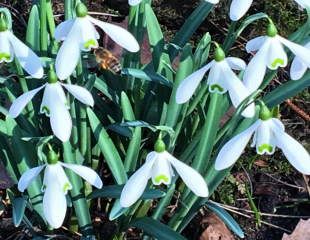
Snowdrops are often listed as "good for pollinators and bees." I like to show that it's actually true. This is not the best photograph; I took it in early February, but it does show a honeybee foraging on snowdrops.
Although a cold time of year, a mild day will bring out the bees enjoying early flowering plants, snowdrops, hellebores, and crocuses are all ideal.
My snowdrops have finished. Can I mow the lawn?
Snowdrops look lovely naturalised in the lawn and will multiply over a number of years to make a great winter carpet.
The question is, after flowering, when to mow the lawn? Snowdrops may not finish flowering until February/early March, depending on variety, and meanwhile, the lawn is ready for its first mow of the season. Snowdrops are like all bulbs, as they die back the leaves feed the bulbs forming for next year's flowers. If you mow the lawn, and with it the snowdrop leaves, you will impair the leaves' ability to feed the bulb and store the nutrients for next year.
In short, don't mow until the leaves have turned yellow.
Two Reasons why your snowdrops may not return
It is disappointing when the lovely display of snowdrops carefully planted last year fail to reappear. The two most likely reasons are lack of water and squirrels.
Too dry: Snowdrops dislike dry conditions, especially when they are getting established. Take care to plant in a spot which has partial shade, not too dry and you will find a good mulch invaluable at helping to retain moisture in the soil.
Squirrel :They are such a nuisance, because they love all bulbs, including snowdrops. Plant with a squirrel barrier, which means mesh over the top to prevent the squirrel from digging the bulbs up.
Where to see a Great Snowdrop Display
In February, it is good to get out for a walk and see some snowdrops. There are many gardens around the country which have impressive displays. To find displays near you, Country life has a good article. In the winter park at Dunham Massey in Cheshire, I captured the lovely image of Snowdrops with the white bark of the birch.
The National Garden Scheme has a Snowdrop festival in February with about 90 gardens all over the country open and you can view how fellow gardeners grow and display their Snowdrops. You can find a Snowdrop garden near you, and with every visit you will be donating to important charities such as Marie Curie, Hospice UK, Macmillan and more.
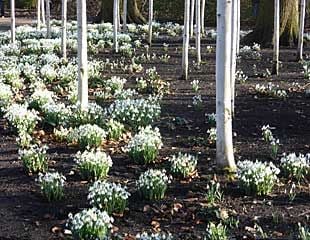
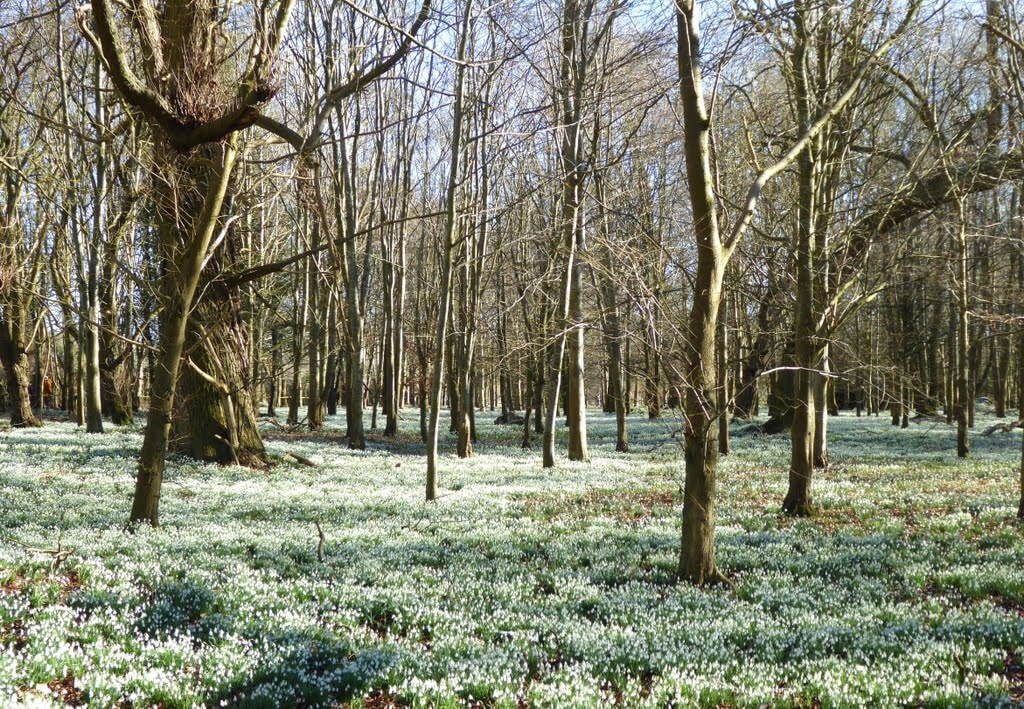
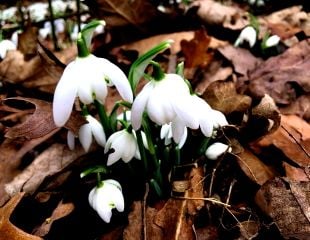
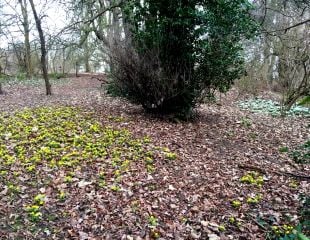
Ideal Snowdrop planting combinations
Snowdrops and Hellebores
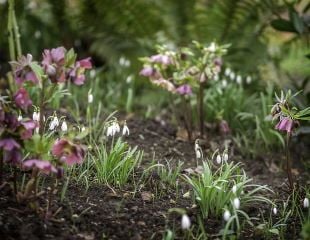
An ideal winter planting combination is snowdrops and hellebores. Both plants enjoy a degree of shade and soil that does not dry out too much.
Snowdrops and Witch hazel
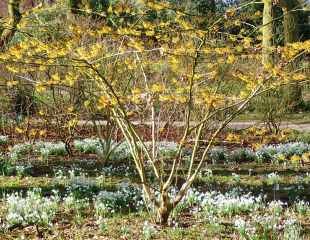
A bright winter combination of witch hazel, hamamelis and snowdrops, both of which enjoy woodland conditions and partial shade.
Snowdrops and Winter aconites
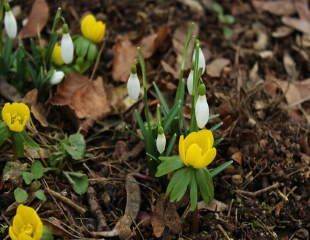
Eranthis hyemalis, winter aconites are a yellow flowering perennial which are a member of the buttercup family and flower early in the year.
Snowdrops and iris reticulata
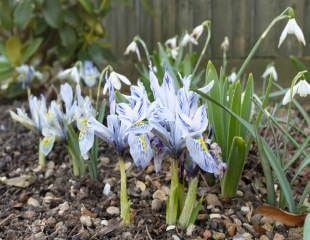
The early tiny Iris reticulata flowers in winter and makes a great companion for snowdrops. It is also a hardy perennial.
Why Are Snowdrops So Hardy and frost resilient ?
Snowdrops survive the most severe weather; they are very hardy and have a selection of clever botanical features which enable them to do so.
Snowdrops have hardened tips on their leaves to help them push up through frost and snow.
The sap of snowdrops contains antifreeze proteins to prevent ice crystal damage in the plant cells during freezing spells. Instead, the plant droops and stands up again when the cold has passed.
Snowdrops multiply by bulb division, but also to a lesser extent by seed. To pollinate successfully and set seed, the seed needs to be kept dry. Snowdrops and nature have a way. The tepals are "thermotropic", which means they actually move adjusting to the temperature. If it dips below 10C the tepals close to protect the pollen, and as the temperature rises, the tepals open and shift slightly to accommodate the pollinating insects.
Such a lot packed into such a tiny plant.
